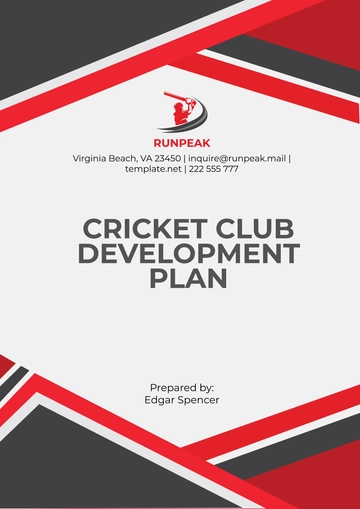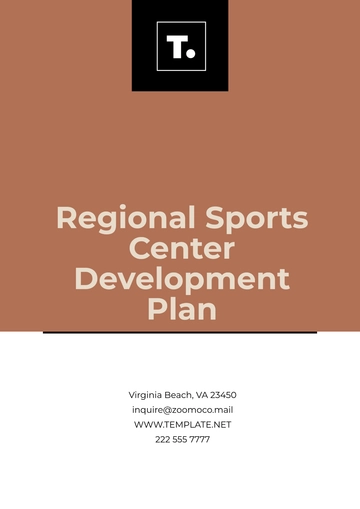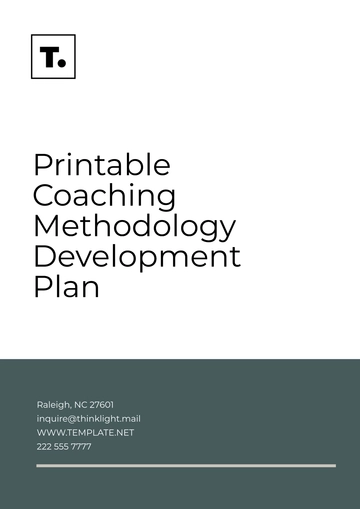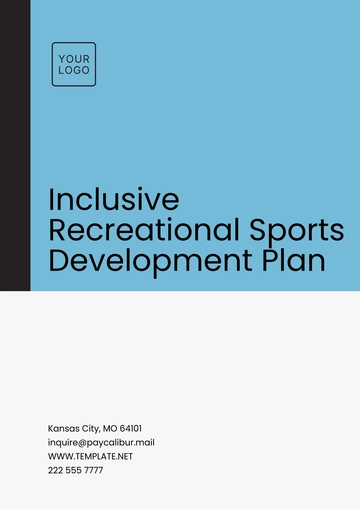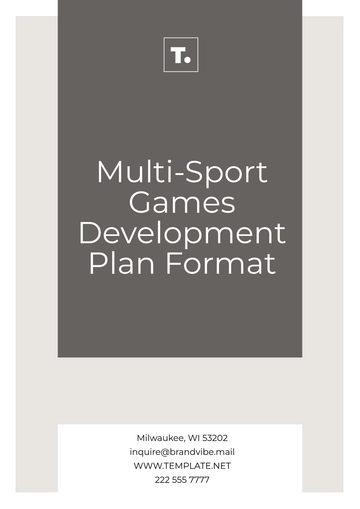Free Sports Academy Curriculum Development Plan

Prepared by: [Your Name]
Date: July 20, 2050
1. Introduction
A. Mission and Vision
The Sports Academy is committed to fostering holistic athlete development through structured training programs, academic support, and leadership opportunities. Our vision is to produce top-tier athletes who excel in both sport and life, embodying discipline, resilience, and teamwork.
B. Purpose and Goals
The goal of this curriculum is to ensure that athletes receive comprehensive training that enhances their technical, physical, mental, and strategic skills in their respective sports. This curriculum will serve as the foundation for both foundational development and elite performance training.
C. Target Audience
Age group: 8–18 years
Skill level: Beginner to elite athletes
Focus: A variety of sports (e.g., soccer, basketball, tennis, swimming)
2. Curriculum Objectives
By the end of this curriculum, athletes will be able to:
Demonstrate improved physical fitness and sport-specific skills.
Grasp the fundamental concepts of sports science, such as nutrition, biomechanics, and psychology.
Develop mental toughness and resilience in high-pressure environments.
Exhibit leadership and teamwork on and off the field.
Show progressive improvements in individual performance metrics.
3. Program Structure
The curriculum is divided into multiple levels based on age, experience, and proficiency. Each level builds upon the previous, gradually increasing in complexity and intensity.
Levels
Level 1: Beginner (8-12 years)
Focus: Basic skills, fitness, and teamwork.
Duration: 1 yearLevel 2: Intermediate (13-15 years)
Focus: Advanced techniques, sports strategies, and mental conditioning.
Duration: 2 yearsLevel 3: Advanced (16-18 years)
Focus: Elite performance, specialization, and leadership.
Duration: 2–3 years
4. Content and Delivery
A. Core Modules
Physical Conditioning
Strength, endurance, flexibility, agility
Injury prevention and recovery techniques
Sport-Specific Techniques
Drills and exercises designed for specific sports (e.g., passing drills in soccer, shooting techniques in basketball)
Skill refinement and tactical understanding
Mental Conditioning
Mindfulness and focus techniques
Visualization, goal-setting, and stress management
Nutrition and Wellness
Understanding proper diet for peak performance
Hydration, recovery, and supplementation
Sports Science
Anatomy and biomechanics relevant to the sport
Use of performance analytics and technology
B. Delivery Methods
Practical Training: On-field coaching, drills, and live game simulations.
Theoretical Learning: Classroom sessions on sports psychology, tactics, and nutrition.
Workshops: Periodic guest speakers and workshops on advanced topics (e.g., sports medicine, career management).
Technology Integration: Use of performance tracking devices, video analysis software, and virtual reality (VR) for tactical simulations.
5. Assessment and Evaluation
A. Performance Tracking
Physical Assessments: Routine evaluations of physical fitness, such as VO2 max measurements, sprint timing, and strength tests.
Skill Progression: Assessment of skills particular to certain sports such as dribbling in soccer or stroke technique in swimming.
Mental Toughness: Evaluating athlete's ability to handle stress, and setbacks, and maintain focus.
B. Types of Assessments
Practical Tests: Hands-on, in-game assessments.
Written Exams: Theoretical knowledge on sports science, nutrition, and mental conditioning.
Continuous Monitoring: Use of video analysis and performance metrics to track improvements.
6. Coaching and Mentorship
A. Coaching Model
Coaches will be assigned based on the athlete’s skill level and specific needs.
Each coach will be responsible for developing personalized training plans that cater to individual strengths and weaknesses.
Mentorship programs will be implemented to guide athletes through their development, focusing on leadership, personal growth, and future career planning.
B. Coach Training
Coaches will undergo continuous professional development, including workshops on sports psychology, new training techniques, and the latest technology in sports performance.
7. Resource Requirements
A. Facilities
Training fields, gymnasiums, swimming pools, and specialized courts.
Access to sports science labs for testing and analytics.
B. Human Resources
Qualified coaches with expertise in various sports disciplines.
Sports psychologists, nutritionists, and strength trainers to support holistic development.
C. Budget
Funding will be allocated for equipment, facilities maintenance, staffing, and athlete scholarships.
Additional investment in technology, such as performance tracking devices, to enhance training and evaluation.
8. Implementation Timeline
A. Phase 1: Curriculum Design & Resource Allocation (0–3 months)
Develop detailed program outlines and schedules.
Secure facilities and resources.
Recruit coaching staff and support personnel.
B. Phase 2: Pilot Program (4–6 months)
Launch a pilot for Level 1 and Level 2 athletes.
Collect feedback and assess the effectiveness of training methods.
C. Phase 3: Full Rollout (6–12 months)
Full implementation across all levels.
Ongoing assessments and refinement of the curriculum.
9. Continuous Improvement and Feedback
A. Feedback Mechanisms
Regular feedback from athletes, parents, and coaches.
Athlete performance evaluations every 3–6 months.
Surveys and interviews to assess program satisfaction and areas for improvement.
B. Curriculum Review
The curriculum will be reviewed annually to ensure it remains relevant to emerging trends in sports science and athlete needs.
Updates will be made based on feedback from stakeholders and new developments in training techniques.
10. Conclusion
The Sports Academy Curriculum aims to develop well-rounded athletes who are equipped with the physical, mental, and strategic tools to succeed both in their chosen sport and in life. By continually refining the curriculum based on feedback and advancements in sports science, we will ensure that our athletes remain at the forefront of athletic excellence.
- 100% Customizable, free editor
- Access 1 Million+ Templates, photo’s & graphics
- Download or share as a template
- Click and replace photos, graphics, text, backgrounds
- Resize, crop, AI write & more
- Access advanced editor
The Sports Academy Curriculum Development Plan Template from Template.net is an editable and customizable solution for designing comprehensive sports programs. Tailor every section to fit your academy’s needs with ease. Fully editable in our AI Editor Tool, this template allows you to create a professional, structured curriculum that suits your goals and vision.





